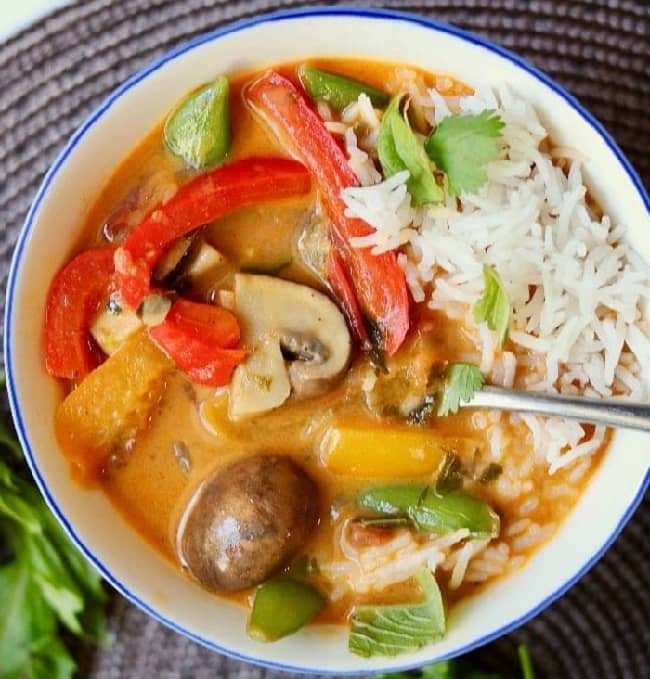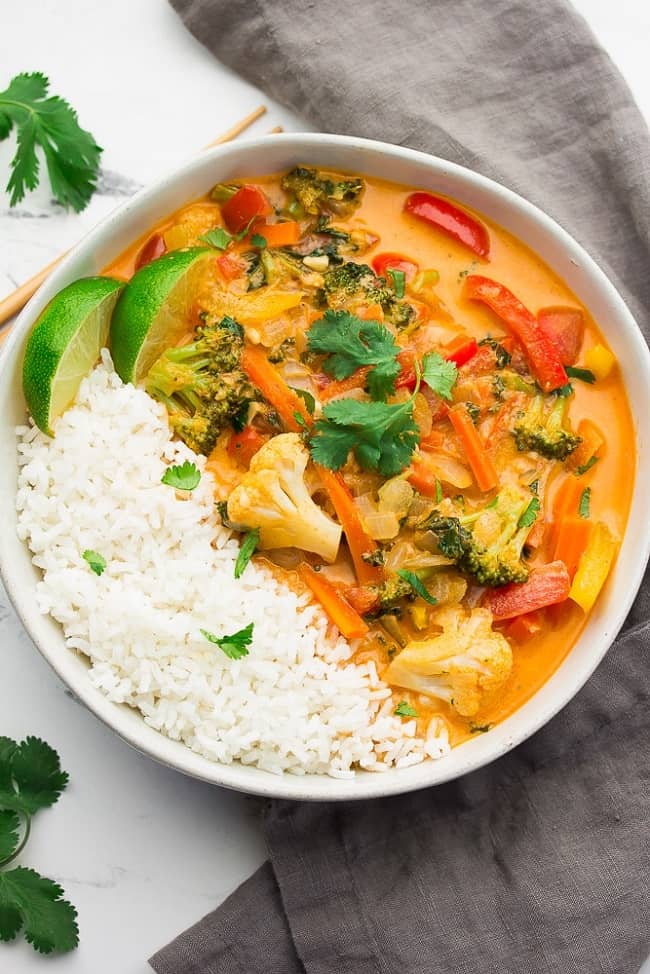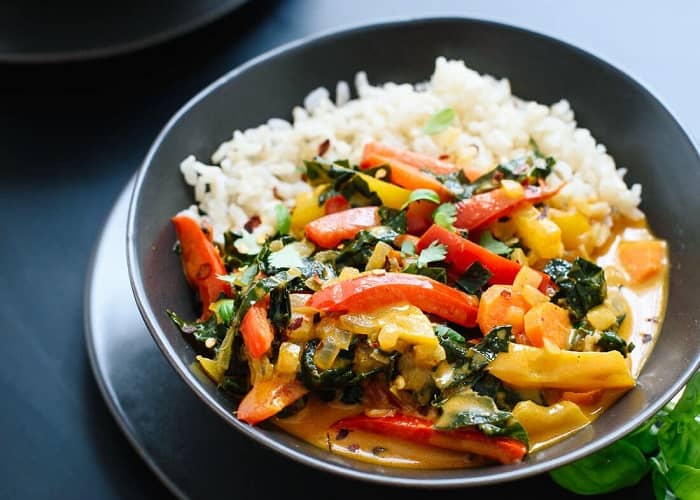- Food: Thai Red Curry with Vegetables
- Writer: Nicolas Wilson
- Content-Type: Food Blog
This Thai Red Curry for last night’s dinner was great, and perhaps this morning’s brunch will be even better.
It’s cozy and comfortable, and it’s ideal for chilly days. It’s also a little rich, but with so many vegetables, it doesn’t feel too heavy.
I’d been planning to make a red Thai curry based on my green curry for a long time, and I’m so glad I did. It’s the finest curry I’ve ever had, even in restaurants! That’s right, I said it.
Bonus? Everything you’ll need for this basic curry should be readily available in a well-stocked grocery store.
Red Curry Recipe Tips
- Using a lot of aromatics like onion, ginger, and garlic is the key to crafting outstanding Thai curries.
- For extra richness, go with full-fat coconut milk (you won’t be sorry!).
- Adding a little rice vinegar and sugar to the mix gives a lot of depth.
- Store-bought Thai red curry paste offers a distinctive Thai flavor and, as an added plus, the Thai Kitchen brand is vegetarian. You can, however, make your own if you’re so motivated.
- You can vary the vegetables as long as they’re all cut into small, uniform pieces. Broccoli, cauliflower, mushrooms, chopped butternut or sweet potato (which will likely take longer to cook), sliced zucchini, and/or yellow squash are also good options.
Thai Red Curry
| Time to Prepare: 10 minutes
30 minutes to Cook 40-minute total time Serves: 4 servings |
This Thai red curry recipe is incredibly simple to prepare at home. It’s far more flavorful and healthier than takeout.
If you want a more traditional Thai curry, swap out the vegetables (you’ll need approximately 3 cups total) and leave out the kale. This dish is suitable for vegetarians, vegans, and gluten-free individuals. There are 4 servings in this recipe.
INGREDIENTS

- 1 ¼ cups brown jasmine rice or long-grain brown rice, rinsed
- 1 tablespoon coconut oil or olive oil
- Pinch of salt, more to taste
- 1 small white onion, chopped (about 1 cup)
- 1 tablespoon finely grated fresh ginger (about a 1-inch nub of ginger)
- 2 cloves garlic, pressed or minced
- 1 red bell pepper, sliced into thin 2-inch long strips
- 1 yellow, orange or green bell pepper, sliced into thin 2-inch long strips
- 3 carrots, peeled and sliced on the diagonal into ¼-inch thick rounds (about 1 cup)
- 1 can (14 ounces) of regular coconut milk, see notes
- ½ cup water
- 1 ½ cups packed thinly sliced kale (tough ribs removed first), preferably the Tuscan/lacinato/dinosaur variety
- 1 ½ teaspoons coconut sugar or turbinado (raw) sugar or brown sugar
- 2 tablespoons Thai red curry paste, see notes
- 1 tablespoon tamari or soy sauce
- 2 teaspoons rice vinegar or fresh lime juice
- Garnishes/sides: a handful of chopped fresh basil or cilantro, optional red pepper flakes, optional sriracha or chili garlic sauce
INSTRUCTIONS

- Bring a big saucepan of water to a boil for the rice. Continue to boil for 30 minutes after adding the rinsed rice, decreasing heat as needed to prevent overflow. Remove the rice from the heat, drain it, and return it to the pot. Cover the rice and set it aside for 10 minutes or more, until ready to serve. Season the rice with salt and fluff it with a fork just before serving.
- Warm a large skillet with deep sides over medium heat for the curry. Add the oil once it’s heated. Add the onion and a pinch of salt and simmer, stirring frequently, for about 5 minutes, or until the onion has softened and turned translucent. Cook, stirring constantly, until the ginger and garlic are aromatic, about 30 seconds.
- Add the carrots and bell peppers. Cook for another 3 to 5 minutes, stirring periodically until the bell peppers are fork-tender. Then add the curry paste and simmer for 2 minutes, stirring often.
- Stir in coconut milk, water, kale, and sugar until everything is well combined. Over medium heat, bring the mixture to a simmer. Reduce heat to maintain a medium simmer and cook, stirring periodically, until the peppers, carrots, and kale have softened to your preference, about 5 to 10 minutes.
- Season with tamari and rice vinegar after removing the pot from the heat. To taste, season with salt (I used 14 teaspoons for the best flavor). Add 12 teaspoons more tamari or 12 teaspoons more rice vinegar if the curry needs a little more punch, or 12 teaspoons more rice vinegar if the curry needs more acidity. To serve, divide the rice and curry among bowls and top with chopped cilantro and a pinch of red pepper flakes, if desired. Serve with sriracha or chili garlic sauce on the side if you like your curries spicy.
Notes
- Look for RED THAI CURRY PASTE in the Asian department of the supermarket. I prefer the vegetarian Thai Kitchen brand. Not all brands are (fish sauce and/or shrimp paste may be present).
- COCONUT MILK: For a thick and creamy curry, use standard coconut milk with guar gum (not light/reduced fat). Native Forest Classic is my personal favorite. Even though the fat level is the same, the ones without guar gum aren’t nearly as creamy.
- ELIMINATE THE GLUTEN: Instead of ordinary soy sauce, make sure to use gluten-free tamari.
- IF YOU WANT TO INCLUDE TOFU, BAKE IT FIRST and then combine it with the coconut milk in step 4. If you use raw tofu, it will absorb too much moisture, and baking it improves the texture significantly.
